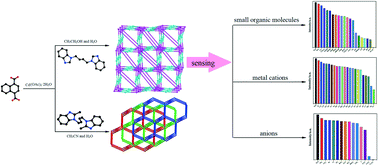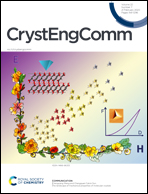A dual-responsive luminescent sensor based on a water-stable Cd(ii)-MOF for the highly selective and sensitive detection of acetylacetone and Cr2O72− in aqueous solutions†
Abstract
Two new water-stable cadmium(II)-metal organic frameworks (MOFs), namely [Cd2(L1)(1,4-NDC)2]n (1) and [Cd(L2)(1,4-NDC)]n (2) (L1 = 1,4-bis(benzimidazol-1-yl)-2-butylene, L2 = 1,4-bis(2-methylbenzimidazol-1-yl)-2-butylene and 1,4-H2NDC = 1,4-naphthalenedicarboxylic acid), were synthesized and characterized. 1 exhibits an unusual 3D framework with the Schläfli symbol of {42·5·62·7}{42·52·72}{42·53·62·73}2, and 2 is a classical sqc6 network. 1 and 2 display excellent pH and water stability, and the integrity of the frameworks was well maintained at different pH values (pH = 3–13) and after long-term water treatment. 1 is the first dual-function luminescent sensor for sensing acetylacetone and Cr2O72− in aqueous solutions with high sensitivity, selectivity and excellent recyclability. This material is an excellent dual-responsive recyclable luminescent sensor.



 Please wait while we load your content...
Please wait while we load your content...